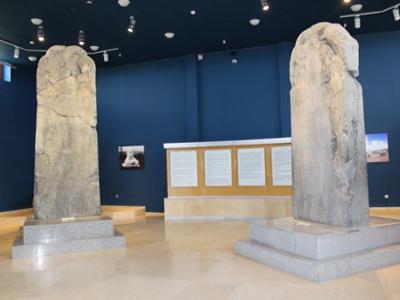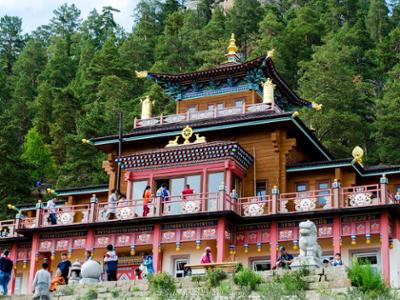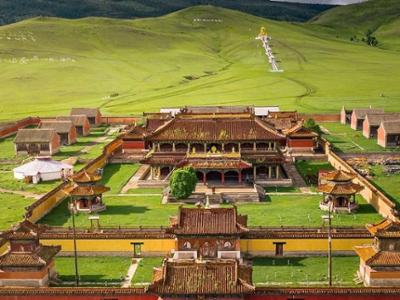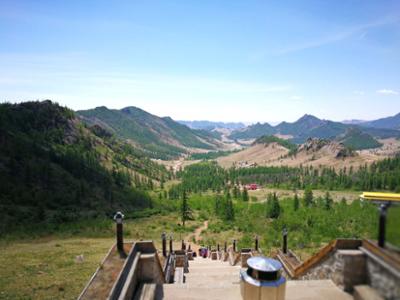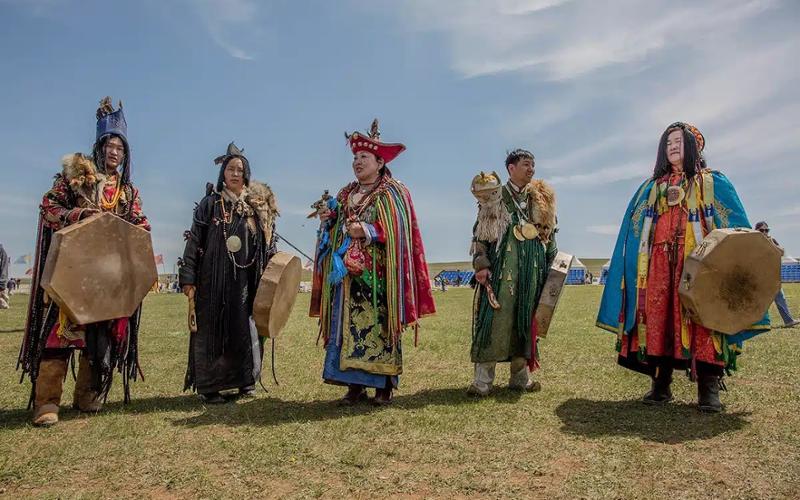
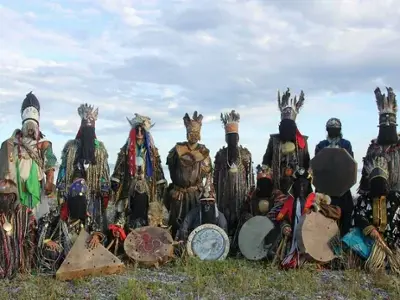
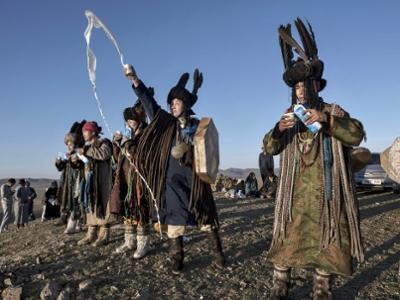
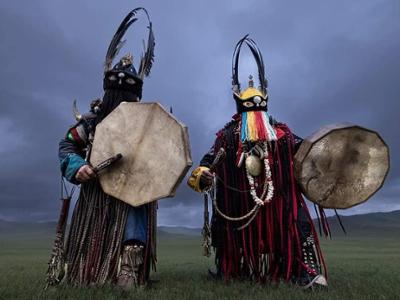
Shamanism is the oldest and most enduring spiritual tradition of Mongolia, a living link between the ancient world and the present. Long before the arrival of Buddhism, the nomadic peoples of the vast steppe looked to the sky, the earth, the mountains, and the wind for guidance. They believed that everything in the universe — animals, rivers, rocks, fire, and even sounds — carried a soul and that the visible world was only a small part of a much larger, sacred reality.
For Mongolians, shamanism is not simply a religion but a way of understanding existence. It is a worldview that sees humanity as part of nature, not above it. In this tradition, life depends on maintaining balance between humans, spirits, and the natural environment. When harmony is disturbed — when someone falls ill, when herds die, or when misfortune strikes — it is believed that the spirits have been offended, forgotten, or neglected. The shaman then becomes the essential intermediary who restores that balance.
Origins and Philosophy
Mongolian shamanism dates back thousands of years. It developed from the daily life of nomads who lived in close contact with the rhythms of the land. In a world of open sky and endless grassland, survival depended on the favor of nature’s spirits. The thunder, the flight of birds, or the whisper of the wind could all carry messages from the unseen world.
At the heart of this belief lies the idea that the universe is alive. Every mountain has a guardian spirit, every river has its soul, and every animal embodies a particular energy. Humans must live in respect and reciprocity with these forces. This is why Mongolians still offer milk to the sky, scatter pieces of butter into the fire, or tie blue scarves (khadag) around sacred stones — gestures of gratitude toward nature’s invisible powers.
The philosophy of shamanism is built on balance. The world consists of both light and shadow, creation and destruction, peace and power. Neither side is “good” or “evil”; both are necessary. The role of the shaman is to keep these energies in harmony — within individuals, families, and the wider community.
The Structure of the Universe
According to Mongolian cosmology, the world is divided into three realms:
- The Upper World — the realm of the gods, celestial beings, and spirits of the sky. It is associated with purity, wisdom, and protection.
- The Middle World — the human world, where people, animals, and nature coexist. It is a place of constant interaction between the material and spiritual dimensions.
- The Lower World — the realm of the ancestors and the under-earth spirits. It is not necessarily dark or evil; it represents the deep, hidden forces of the earth and memory.
The shaman is the traveler between these three realms. Through trance, prayer, drumming, and chanting, the shaman’s soul leaves the body and journeys into these dimensions to seek answers, deliver messages, or bring healing. Each world has its own spirits and laws, and only a trained shaman knows how to navigate them safely.
The Spirits and Ancestors
In Mongolian shamanism, the most revered spirits are the Ongod — ancestral entities who continue to exist after death. They are the protectors of families, clans, and sacred places. Each shaman has their own Ongod, inherited through bloodline or received during initiation. These spirits act as guardians, helpers, and teachers.
The Ongod live within ritual objects — stones, wooden idols, or even the shaman’s drum and clothing. When the shaman calls them during a ceremony, they are said to “descend” into these objects or into the shaman’s body, lending their power and wisdom.
Besides the ancestors, there are spirits of mountains, rivers, animals, and the sky. Among them, the most sacred is Tenger, the Eternal Blue Sky, the supreme force that governs all existence. To Mongolians, Tenger is not a distant god but the living presence of the universe itself — limitless, luminous, and eternal.
The Shamanic Rituals
A shamanic ceremony is both a healing act and a sacred performance that unites community, nature, and spirit. It usually takes place outdoors — beside a river, under an open sky, or around a fire. The preparation is meticulous: the space is purified with burning herbs such as juniper or artemisia; offerings of milk, vodka, or butter are made; and the drum is awakened with soft rhythmic beats.
As the ritual begins, the shaman dons their ceremonial costume — a leather and iron outfit covered with bells, feathers, ribbons, and symbols of power. Each ornament carries meaning: iron represents strength, feathers symbolize flight and communication with the sky, and small mirrors reflect and repel harmful forces.
The drum, called khengereg, is the heart of the ritual. Its beat represents the pulse of the Earth, and its sound becomes the shaman’s horse that carries their soul through the spirit worlds. As the drumming intensifies, the shaman chants, moves, and enters a trance. Their breathing changes, their gestures become fluid, and their consciousness travels beyond the ordinary.
In this state, the shaman may call upon spirits, communicate with ancestors, or fight harmful energies. The ceremony might aim to heal illness, bless a newborn, ensure a successful hunt, purify a home, or restore luck. The rhythm of the drum, the firelight, and the collective emotion of the participants create an atmosphere of deep transformation.
White and Black Shamanism
Within Mongolia, there are two main forms of practice — White Shamanism and Black Shamanism.
- White shamans work with benevolent, celestial spirits. Their rituals focus on blessings, healing, fertility, and the protection of families.
- Black shamans call upon more powerful and sometimes fierce spirits. Their role is to defend, to exorcise, and to confront destructive or malevolent forces.
Both forms are considered sacred and necessary. They are not opposites of good and evil but two complementary paths maintaining universal balance. In some regions, there is also Yellow Shamanism, a syncretic tradition that blends ancient shamanic practices with elements of Tibetan Buddhism — chants, prayer flags, and the philosophy of compassion.
The Message of Shamanism Today
Even in modern Mongolia, shamanism remains a living tradition. Despite centuries of suppression during the socialist period, it has reawakened with the fall of communism. Today, shamans perform ceremonies in both rural and urban settings. People visit them not only for healing but also for guidance, emotional balance, and spiritual renewal.
For many Mongolians, shamanism represents continuity — a bridge between the ancient nomadic soul and the modern world. It reminds them that humans are part of a larger ecosystem, that respect for nature is not optional, and that gratitude is the foundation of harmony.
To witness a shamanic ceremony in Mongolia is to experience one of humanity’s most ancient spiritual expressions. The beat of the drum, the rising smoke, and the chants echo through the steppe, carrying the same energy that once guided the first nomads. It is a celebration of life, of connection, and of the eternal dance between earth and sky.
Essence of Mongolian Shamanism
At its heart, Mongolian shamanism teaches a timeless truth: that all things are alive, interdependent, and sacred. Humans are not masters of nature but its companions and guardians. To live in balance is to honor the spirits of the land, to care for one’s ancestors, and to listen to the whisper of the wind — because every sound, every movement, and every life is a message from the world of the spirits.

